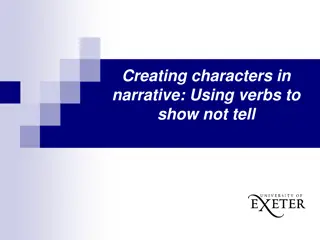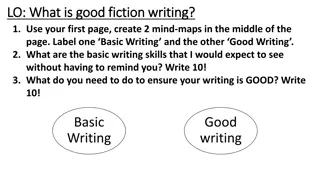Unveiling Character Depth in Fiction Writing
Discover the essence of character development in fiction writing through revealing dialogues, appearance cues, actions, and critical decision-making moments. Dive into how characters come alive through thought-provoking narratives, adding layers of intrigue and authenticity to your storytelling.
Uploaded on Sep 15, 2024 | 0 Views
Download Presentation

Please find below an Image/Link to download the presentation.
The content on the website is provided AS IS for your information and personal use only. It may not be sold, licensed, or shared on other websites without obtaining consent from the author. Download presentation by click this link. If you encounter any issues during the download, it is possible that the publisher has removed the file from their server.
E N D
Presentation Transcript
Characters How to reveal who they are; why that matters
Character: the foundation of fiction writing Even if they re animals or aliens, it s not a story without a feeling being living in a world. We must find them interesting, believable and care about them. A character can be revealed through dialogue, appearance, action, thought and other character reactions.
Character Appearance Even when there is a conflict between a character s appearance and who he really is, readers must see the appearance in order to know this. Facial features, body shape, clothing, and objects can make statements of internal values that are political, religious, social, intellectual and important. The man in a suede jacket is making a very different statement than the one in a dirty sweatshirt. Even if clothing is prescribed by work, that s important to know, too. Also think about how your character walks, crosses her legs, flips a pencil, scratches a mosquito bite, sits on the ground, shaves her legs (or doesn t). Again, select the details that matter, the ones that show who this is.
Revealing Character through Action Action in fiction is change, not always violence, betrayal, revenge, chase scenes and the like. Human beings face chance and choice or discovery and decision. Some parts of life and fiction are involuntary we don t choose to find out our father has a secret second family (for example), but then we have to decide what s next, how we ll respond. It might be simple bad luck that we got into a car accident, but then we have to decide whether or not to try to avoid reporting it considering the drugs or mistress or dead body in the car.
This passage from Toni Morrisons Recitatif shows movement, discovery, then decision: It was August and a bus crowd was just unloading. They would stand around a long while: going to the john, and looking at gifts and junk- for-sale machines, reluctant to sit down so soon. Even to eat. I was trying to fill the coffeepots and get them all situated on the electric burners when I was her. She was sitting in a booth smoking a cigarette with two guys smothered in head and facial hair. Her own hair was so big and wild I could hardly see her face. But the eyes. I would know them anywhere. She had on a powder-blue halter and shorts outfit and earrings the size of bracelets. Talk about lipstick and eyebrow pencil. She made the big girls look like nuns. I couldn t get off the counter until seven o clock, but I kept watching the booth in case they got up to leave before that. My replacement was on time for a change, so I counted and stacked my receipts as fast as I could and signed off. I walked over to the booth . . . Every story develops a pattern of change, in which small and large changes are made through discovery and decision.
Revealing Character through Thoughts We all have a private mental life, things we think about, plan, ponder, remember. A rich characterization includes private worries, philosophical musings and fantasies of revenge or sex or food or shame or personal glory (or whatever). While you might not want to show EVERY thought (stream of consciousness can be tiring for readers), dipping into your character s mental life at important junctures can help make him or her more real, more layered to readers, because nobody says everything she/he thinks. Like dialogue, thoughts can be offered as summary (He hated the primitive way she ate.) or as the exact words in the brain (Why did she clench her knife in her fist like a gorilla?)
Interpretation by another character Example: before,--she likes to go her own way to work; she does not like to be dictated to; she takes her own independent walk whenever she can; she certainly has a little spirit of secrecy, and independence and nonsense, about her, which I would advise her to get the better of. As a general reflection on Fanny, Sir Thomas thought nothing could be more unjust, though he had been so lately expressing the same sentiments himself, and he tried to turn the conversation, tried repeatedly before he could succeed. There is something about Fanny, I have often observed it (Jane Austen, MansfieldPark) The first speaker, Mrs. Norris, reveals at least as much about herself as about Fanny (doing two things at once). It s also very useful for developing tension to see how Fanny is interpreted by others, perhaps falsely. It shows the social expectations of her world and creates the container that shapes her character.
Summary Try to reveal who your character really is rather than issue a police report. All of these areas are rich sources of information about your character: dialogue appearance action thought other character reactions.























